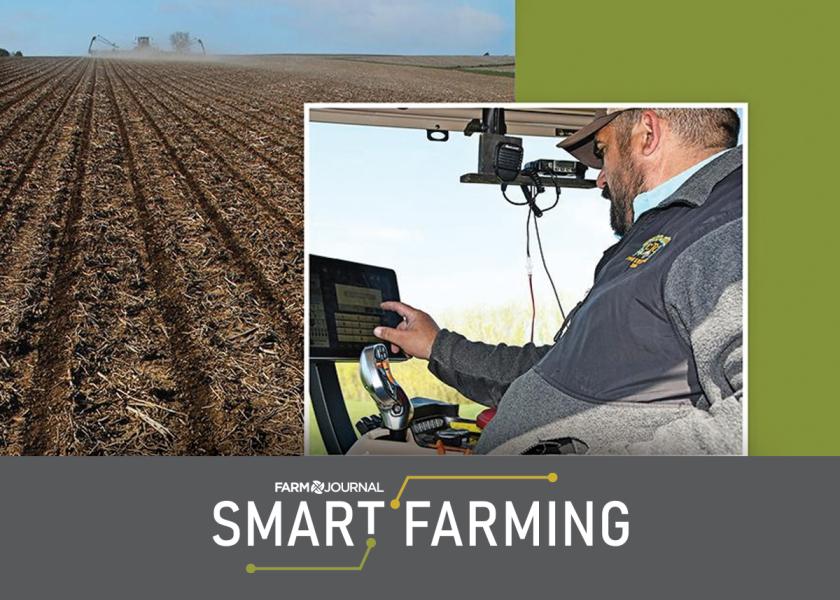Use Technology to Build the Perfect Furrow

Farm Journal’s Smart Farming Week is an annual week-long emphasis on innovation in agriculture. The goal is to encourage you to explore and prioritize the technology, tools and practices that will help you farm smarter. Innovation today ensures an efficient, productive and sustainable tomorrow.
New planter technology, designed to create that perfect furrow, can be a game-changer in terms of yield for many operations, says Farm Journal Field Agronomist Ken Ferrie.
“Planter technology was stagnant for many years,” he notes. “The emphasis was on acres per day rather than a picket-fence stand, but now plant spacing and uniformity have moved to the forefront. There has been an explosion of technology to help you manage the furrow.”
Here are some factors to consider as you plan your next steps toward the perfect furrow and higher yield:
More Sensors, Less Stress
It’s still up to you to determine seed depth. “Seed must be deep enough for root development and water uptake, but not so deep as to cause emergence issues,” Ferrie says. “But after that, technology can alleviate the planting stress that had Dad and Grandpa hopping off the tractor to check seed depth and furrow closure, hoping soil conditions didn’t change.”
Sensors can tell you if you are maintaining depth. Use that data to set the correct downforce, he says, with either mechanical springs, airbags or hydraulic downpressure.
Today’s hydraulic downpressure systems can identify when units come out of the ground and apply additional force in a millisecond, while the planter travels the width of a pickup tire track, Ferrie adds. (Those tracks sometimes show up on as-applied maps showing downpressure changes across a field.)
Ground Truth Downpressure
While technology helps keep units in the ground, you still must determine the amount of downforce, Ferrie says.
“When you enter a field, reduce downpressure until you find the spot where you are not maintaining good ground contact,” he says. “Dig in the furrow to find the seed, measure to the next seed and cross-cut the furrow to check the seed environment.”
If the seed is being placed nicely with no dry soil around the seed, add downforce until the sensors say you are reaching 95% ground contact.
”Then go back to the furrow, dig and do another cross-cut,” Ferrie says. ”If the seed is tucked in nicely, with no dry soil around it and no smeared sidewalls in the furrow, that’s the sweet spot for downpressure.”
Besides maintaining ground contact, you need enough downforce to firm sidewalls and prevent sloughing soil off onto the seed. If the sidewalls aren’t firm, dry soil at the top will fall onto the seed before the slot closes.
“This is often a problem in finely worked, dry soil, when the field cultivator gets too far ahead of the planter on hot, windy days,” Ferrie says. “If necessary, increase downforce to keep the furrow walls standing until you place the seed in the furrow and close it from the bottom up.”
If your soil finisher shears 4" of soil uniformly across the field for the planter to run in you may not need to change downpressure on the go, adds Ferrie: “But in all other environments, this technology is essential. Every soil needs its own downpressure setting.”
Look Inside the Furrow
Besides depth and spacing, sensors can tell you the temperature and moisture at planting depth, the organic matter content and cation exchange capacity and the cleanliness of the furrow from residue.
“If the soil is cold, and the forecast calls for more cold temperatures, you can stop planting rather than lose plants to seed chilling,” Ferrie says.
Sensing residue in the furrow is important if you grow conventionally- tilled continuous corn or if you run a wavy colter without row cleaners.
“Often, growers who run a wavy coulter in no-till or strip-till leave it on when they plant conventionally tilled corn,” Ferrie says. “In tilled soil, with no ‘cutting board’ to operate against, the colter will pin a lot of trash in the furrow, causing big issues.”
What technology should you buy? When weighing a new technology, Ferrie says:
- Buy technology to solve a specific problem. What improvement will the technology achieve versus your current system?
- Avoid change for the sake of change. Because your neighbor likes a new system or because a salesperson says you need it are not valid reasons to buy new technology.
- “If you are planting in timely fashion now, a high-speed planter probably won’t increase your yield,” Ferrie says. “But if you are always pushing planting conditions, a high-speed planter might be a good investment — if you have enough patience to wait for ideal planting conditions.”
Here are a few more stories to help you prepare for planting season.
Your 19-Point Planter Checklist to Ensure Smooth Spring Planting
Fertilizer Relay System Gives Corn a Big Push Out of the Gate








